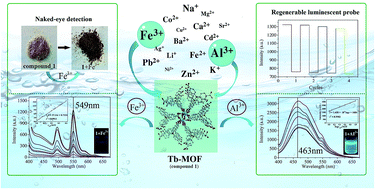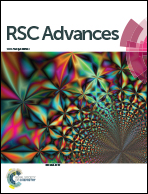Tb-MOF: a naked-eye and regenerable fluorescent probe for selective and quantitative detection of Fe3+ and Al3+ ions†
Abstract
Sensitivity and selection for metal ion detection are of crucial importance in protecting human health. Using 4,4′,4′′-tricarboxytriphenylamine (H3TCA) as the ligand, a unique terbium based metal–organic framework (Tb-MOF), [Tb3(TCA)2(DMA)0.5(OH)3(H2O)0.5]·3H2O (1), has been prepared, structurally identified and further employed as a fluorescent probe for selective and quantitative detection of metal ions. Compound 1 selectively detects Fe3+ and Al3+ through fluorescence quenching effects at 549 nm and fluorescence enhancement at 463 nm, respectively, from among 19 types of metal ions without interference. Most notably, compound 1 exhibits a clearly visible color change in the presence of Fe3+ from yellow to deep brown, with a detection limit of 8 × 10−6 M. As a fluorescent probe for Al3+, 1 can be simply and quickly regenerated. Its detection limit of 7 × 10−7 M is significantly lower than the highest limit of Al3+ in drinking water recommended by the WHO (7.41 μM), representing a rare example in reported fluorescent sensors for Al3+. Tb-MOF 1 is an example of a fluorescent probe that features naked-eye detection, regeneration, high selectivity and quantitative detection of Fe3+ and Al3+ ions.


 Please wait while we load your content...
Please wait while we load your content...